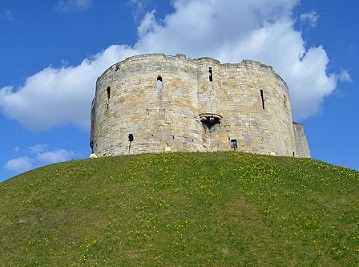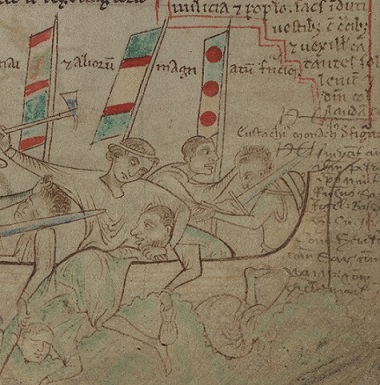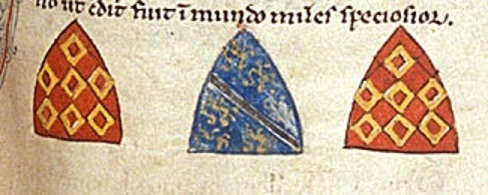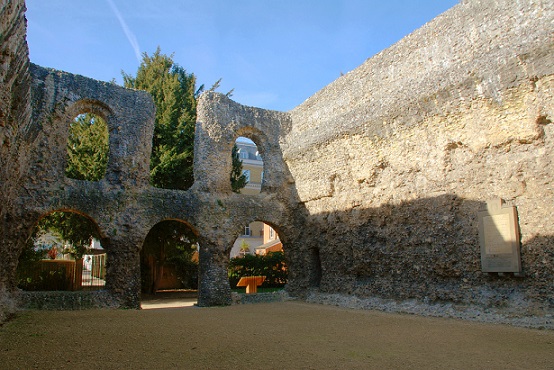On Sunday, Monday and Tuesday this week the King rode out, as before, from Windsor to Runnymede. He last visited Runnymede on 23 June, exactly a fortnight after his first appearance there, on 10 June. Leaving Windsor on Friday 26 June, after what had to date been the longest stay he had passed in any single royal residence, he then travelled via Odiham to Winchester.1 Despite the efforts made this week and last to re-establish peace, it is tempting to suggest that John's departure for Winchester marked the resumption of the pattern of May and early June, in which the King was confined to those parts of southern England still firmly under royal as opposed to baronial control. This week, as last, the principal business recorded in the chancery rolls lay in the restoration of former rebels and the adjudication of disputes over land and office. So many such orders were issued that we must review them group by group.
To begin with, there were commands for land to be returned to former owners who were clearly or explicitly stated to have been disseised by the King's 'will' or without judgment. Confining ourselves for the moment to the upper levels of the baronial twenty-five, we find Hertford castle restored to Robert fitz Walter as his right ('ius suum')2; the manor and honour of Trowbridge (though not as yet the castle) recovered by Henry de Bohun from William earl of Salisbury3; commands for arrears owing to the earl of Hereford to be paid from the county farm (presumably of his third penny of pleas)4; inquest into the claims of William de Mowbray to a hereditary right in York castle, the forest of Yorkshire and the manor of Pocklington5; the restoration to Roger de Montbegon of lands in Lancashire and Nottinghamshire that he had been granted by John in the 1190s before his accession as King6; restoration to Geoffrey de Mandeville of his father's manor of Kingshill (Buckinghamshire) and inquest into his rights within the honour of Gloucester, including his claims as patron of the religious, and his chaces at Bristol, Keynsham and Cranbourne7; restoration to Richard de Montfichet of office as forester of Essex, seized from his father as long ago as the 1170s8; the restoration to Eustace de Vescy of hunting rights in Northumberland, and to Robert de Brus of a fair and market at Hartlepool first granted by charter to his father9, and restoration to Robert de Vere of the third penny of pleas as earl of Oxford.10 Richard de Clare, whose daughter had been married to William de Braose the younger, was promised restoration of the Braose manor of Buckingham, held in the meantime by the King's Angevin adherent, Ivo de la Jaille.11 The Crowland chronicler refers specifically to the King's release of hostages and to his surrender of the castles of Mountsorrel, Rockingham and Colchester, that either John or his elder brother, King Richard had long occupied.12
Related to such claims were a series of restorations to members of the twenty-five of land that had been taken from them at an indeterminate time, perhaps merely from the start of the war, perhaps on a longer term basis. In this way William of Huntingfield secured restoration to himself and his son-in-law, Hugh Rufus, of land in Worcestershire and Hampshire13; William de Mandeville was restored to land at Aylesbury and Berkhamsted, Henry de Bohun to Ryhale in Rutland, William de Lanvallay to the manor of Kingstone in Somerset14, and Robert de Vere to unspecified estates.15 Eustace de Vescy and Gilbert de Ghent were promised custodies that might have been confused with lands of the honour of Richmond.16 Geoffrey de Say was to be granted custody of a Kentish heir, seized by the King by confusion with the estates of St Augustine's Canterbury.17
Beneath this upper layer of baronial grievances, several barons not of the twenty-five were judged to have been deprived of lands or offices now to be restored. These restorations included the castles of Richmond (restored to Roald fitz Alan)18, Launceston (to Robert de Cardinan)19, Rockingham (to William Mauduit)20, and the forest of Cannock and castle of Rodbaston (Staffordshire) restored to Hugh of Leigh.21 Ralph and Robert de Grelley were ordered restored to land in Nottinghamshire22, and Matilda de Courtenay to a portion of the honour of Wallingford disputed by Robert de Courtenay.23 Equally interesting are those instances in which relatively minor individuals were judged to have been unjustly or arbitrarily deprived. Thus Ralph Chenduit's claim to have had land unjustly seized from him at Nettleden in Hertfordshire was to be considered.24 William fitz Elias was to have the land at Oakley in Buckinghamshire judged to belong to him25, and Roger de Leonibus was to be restored to land at Begbroke in Oxfordshire taken from him without judgement and 'by the King's will' ('per voluntatem nostrum').26 It is worth noting that several of these cases involved land in the honour of Wallingford . As Christopher Tilley has argued, the inclusion of Wallingford in Magna Carta clause 43 reflected not just its significance as an escheated honour but the peculiar pressures placed upon its tenantry, now holding their lands directly from a notoriously rapacious King.27
Some restorations, such as those to Henry of Braybrooke, William of Eynsford, William de Cahaignes, Hugh de Hauville, William Martel, or to Peter fitz Oger ('because he was believed to be with the rebels'), seem merely to have been of land seized in the late war.28 In the same category, we find orders for the release of hostages taken from the men of Dunwich (as long ago as 1214)29, from the mercenary Eustace the Monk30, from Ireland31, from David earl of Huntingdon (including John his son)32, land from the vill of Northampton33, and from John le Vicomte.34 Other royal letters perhaps reveal attempts to remedy more ancient injustices. Thus Eudo Arsic was to have his market at Dunham in Norfolk, despite the illegitimate attempt to raise a rival market at Swaffham.35 John of Stanford was to have his office in the Queen's chamber36, and Walter Buistard was to be restored to custody of the manor of Brill and the King's houses in Oxford.37 Henry, son of earl David of Huntingdon, was to have land at Godmanchester previously taken from him 'without judgement'.38
Each one of these disputes must have involved negotiation, in many instances with complicated claims and counterclaims stretching back as much as fifty years or more. In the present week, there seems to have been a particular focus upon Irish affairs, no doubt as a result of the presence of court of the Irish justiciar, Henry archbishop of Dublin. Here too we find a series of negotiated compromises, including the recognition of liberties claimed by Henry Tirel and by the men of Limerick.39 On 27 June, at Winchester, at least three charters were issued, witnessed by the archbishop of Dublin and other Irish lords, conferring favours in Ireland upon Alan fitz Roland (of Galloway), his brother, Thomas of Galloway earl of Atholl, and the church of St Patrick Dublin, the first two of these rewarding Scots adventurers already allied to the cause of King John.40 As with the only other charter recorded this week, confirming Roger de Neville in possession of land at Rockingham which he was to hold, regardless of the restoration of Rockingham castle to William Mauduit, it is worth noticing here that, despite the attempted reconciliations of the previous week, the witness lists to these documents were all dominated by staunch royalists, with no further appearances by any of those who had been in rebellion in May or June.41
As this should confirm, relations between King and the former malcontents remained strained, whatever the apparent calmness of the restorations and remedies that the King commanded. Saher de Quincy, for example, had once been a favoured member of the King's entourage. He had gone into rebellion in April or May and duly appeared as one of the baronial twenty-five. On 21 June, he was ordered to restore Fotheringay Castle, previously in his custody, to earl David of Huntingdon, provided that Earl David had first done homage for it to the King.42 As noted by J.C. Holt, this command supplies proof of the extent to which the restoration of rebel homages was central to the peace agreed on 19 June.43 At the same time, it also suggests deliberate mischief-making by the King, in stirring up rancour between Saher and David, two of the leading baronial malcontents, each with close connections to the kingdom of Scotland. On the same day, orders were issued to investigate the ownership of a cargo of wine seized by the men of Winchelsea. If it was found to belong to the men of Rouen, it was to be released without delay. If to the men of London, however, it was to remain in the King's keeping.44 Clearly, the King was conscious of the need to maintain pressure on the city of London, still in the keeping of Langton and the twenty-five barons.
Langton himself was owed 2000 marks, apparently pending from the settlement of damages owing from the time of the Interdict. Unlike the other bishops, including the bishop of Lincoln, who seem to have waived their damages in return for favours elsewhere, Langton was prepared merely to respite half of the money owed until the coming Michaelmas, even then insisting that it be paid with promptness when the new term fell due.45 Langton's steward, Master Elias of Dereham, was at this same time involved intimately not only in the dispatch and publication of the letters establishing peace but in the publication of Magna Carta. On 21 June, he appears as one of those attempting to calm relations between England and the county of Flanders, disturbed since May by the mutual seizure of shipping and merchandise.46 Langton's own continuing role in politics is most clearly revealed in letters of 27 June, sent into all of the counties of England, commanding the sheriffs and the twelve knights appointed to investigate and suppress abuses to seize the lands and chattels of all those who had refused to swear the oaths to the twenty-five demanded by Magna Carta. Should such contrariants continue to refuse these oaths after a further fifteen days, their lands were to remain in royal custody but their chattels were to be sold and any profit put aside for the uses of the forthcoming crusade: a provision made 'by judgement of the lord archbishop of Canterbury and the barons of our realm'.47 Here, we find Langton acting in close association with the barons to secure oaths that, in the longer term, could hardly have been welcome to the King.
Meanwhile, Langton's decision to maintain the Church's financial pressures upon the crown could not have come at a more inconvenient moment. The King was by this time desperately short of cash. Not only had the operations of the Exchequer collapsed as a result of the rebel seizure of London, but in many counties, the rebels had appointed their own sheriffs to collect local revenue for baronial rather than royal profit. In the present week, a series of letters commanded the appointment of new, and presumably more reliable sheriffs to the counties of Kent and Surrey (taken from Reginald of Cornhill and entrusted to Hubert de Burgh), Lincolnshire and Norfolk and Suffolk (taken from John fitz Robert and entrusted to John Marshal), Buckinghamshire and Bedfordshire (entrusted to Walter de Neville), Sussex (entrusted to Matthew fitz Herbert), Northampton (entrusted to William of Duston), Dorset and Somerset (entrusted to Ralph of Bray), and Essex and Hertfordshire (entrusted to Matthew Mantel). These arrangements were accompanied by a transfer of castles (Canterbury and Dover to Hubert de Burgh, Norwich and Orford to John Marshal).48 They ensured that the enforcement of the letters, issued on 27 June, calling for the seizure of land and chattels from those who had refused to swear to the twenty-five, was supervised not by baronial but by staunchly royalist representatives. The new sheriffs can perhaps be identified with those known as the 'sheriffs of peace' ('vicecomites pacis') whom the Crowland chronicler tells us were appointed throughout England, but whose interventions, the chronicler implies, were resisted at a local level by the barons.49 The duties of John Marshal at Lincoln would have included putting an end to the rebel occupation of the city and the siege of Lincoln castle, ongoing since early June.50 William of Duston, before his appointment to Northampton, had apparently assisted, or perhaps even led the royalist garrison in the Tower of London, now surrendered to Archbishop of Langton under the terms of the treaty involving London.51
Meanwhile, to secure a supply of cash, the King called for money previously deposited at Marlborough and Bristol.52 On 24 June, he resorted to more desperate measures, calling upon the abbots or keepers of seventeen monasteries and nunneries, in all parts of England as far north as Yorkshire, to deliver up whatever treasure the King had left in their custody.53 Within only two days, this precipitated a great flood of precious items: shrines of silver and ebony, a gold vase with pearls sent by the Pope, a large quantity of silver cups or basins, jewelled sceptres, belts decorated with jewels or with the Plantagenet 'lioncels' (little lions), delivered up by the religious of Reading, Merton and Waltham Abbey.54 What is perhaps most remarkable here, as was to be shown in future weeks, was the speed of communication that this implies. Orders dispatched from Windsor to Essex on 24 June were answered within two or three days; by 4 July they had not only reached but been answered as far away as Burton in Staffordshire.55 It was on this same occasion that the prior of Reading handed over 'all our rolls of our chamber and our seal and our rolls of our Exchequer', apparently evacuated from London before the rebel seizure of Westminster and entrusted since May to the Reading monks.56 A routine order to the barons of the Exchequer, sent on 24 June, suggests the makeshift reconstitution of the King's financial operations, perhaps now operating from Winchester rather than Westminster.57
In the absence of ready cash, the King still had favours to distribute: licence to William Marshal to buy as many hawks as he wished at the fair of King's Lynn, gifts of deer to John Marshal from the bishop of Norwich's park at Elmham, the right to private assarts and preferential farms to the earl of Arundel and Roger de Beauchamp, and of a wardship for Ralph de Trubleville.58 To fill longstanding vacancies, on 24 June the King assented to the election of Sybil, prioress of Barking as abbess of the same, and on the following day to the election of Master Robert of York as bishop of Ely.59 In the case of Master Robert, the King was perhaps bowing to pressure from archbishop Langton. Certainly, lack of royal enthusiasm for Robert's election was to lead, within the next few months, to the countermanding of orders for his consecration and to royal support for Geoffrey de Burgh, brother of Hubert, whose botched election to Ely had first persuaded the Ely monks to attempt the promotion of Master Robert.60 Meanwhile, the bishoprics of Durham and York both remained vacant, and the see of Carlisle threatened to secede to Scotland, leaving the north of England without effective ecclesiastical control.
Thus far, in the immediate aftermath of Runnymede, the King could claim to have done as much as the barons to ensure the effective implementation of the peace offered in Magna Carta on 15 June and solemnized four days later with the reacceptance of rebel homages. There remained, however, one respect in which the King still balked at implementing the charter's full terms. Clauses 50 and 51 of the charter had demanded the dismissal from office of half a dozen of the King's best trusted alien constables and the expulsion from England of all foreign mercenaries. From Runnymede, on 23 June, the King wrote to the Flemish mercenary captain, Hugh de Boves, ordering him to retain none of the knights or serjeants currently at Dover but to ensure their return to their own parts overseas.61 Commands nonetheless continued to be issued to Peter de Chanceaux at Bristol, to Engelard de Cigogné at Gloucester, and to Geoffrey de Martigny at Northampton, all three of them in theory placed under the ban of Magna Carta clause 50. In practice these men were too significant to the royalist cause to be so lightly dismissed.62
1 | For the expectation on 23 June that he would be at Winchester rather earlier than this, on 25 June, see RLP, 144. |
2 | RLP, 144b. |
3 | RLC, i, 215, and cf. King John’s Diary and Itinerary 14-20 June. |
4 | Rot.Ob., 553. |
5 | RLC, i, 215, an entry that is somewhat over-interpreted by J.C. Holt, Magna Carta (2nd edn., Cambridge, 1992), 166-7, 431-2. |
6 | RLC, i, 215b. |
7 | RLC, i, 216-16b. |
8 | RLP, 144, and see here N. Vincent, ‘Montfichet, Richard de (b.after 1190, d. 1267)’, Oxford Dictionary of National Biography (Oxford, 2004; online edn., Oct 2005) [http://www.oxforddnb.com/view/article/19044, accessed 16 Aug 2015]. By 24 June, he was being addressed in his recovered capacity as forester: RLC, i, 217. |
9 | RLC, i, 216b, 217b. |
10 | RLC, i, 216. |
11 | RLP, 143b, where Ivo's men were promised that their lord would be compensated elsewhere. The de la Jaille custody of Buckingham is to be considered in detail in a forthcoming paper by Daniel Power, read at our conference in June 2015. |
12 | Memoriale fratris Walteri de Coventria, ed. W. Stubbs, 2 vols. (London, 1872-73), ii, 221. Orders for Rockingham to be granted to William Mauduit were issued in the present week (see below). Mountsorrel was given to Saher de Quincy the week after (King John’s Diary and Itinerary, 27 July - 2 August). Colchester was apparently not surrendered to William de Lanvallay until the end of July (King John’s Diary and Itinerary, 27 July - 2 August). |
13 | RLC, i, 215b. |
14 | RLC, i, 216b-17, and cf. VCH Somerset, iii, 205. |
15 | RLC, i, 215b. |
16 | RLC, i, 215b. |
17 | RLC, i, 216b. |
18 | RLP, 143b. |
19 | RLP, 144. |
20 | RLP, 144b. |
21 | RLP, 144. |
22 | RLC, i, 215, 217, accompanied by a gift of six hinds to Robert from the King's forest of Cliffe: RLC, i, 215. For Nettleden ('Netteleg'), see The Place Names of Hertfordshire, ed.J.E.B. Gover and others, English Place-Name Society (1938), 48. |
23 | RLC, i, 215, covering the vill of Waddesdon ('Wtesdon') (Buckinghamshire), and for the disputes within the Courtenay family here, between Robert, a son of Reginald de Courtenay, and a French kinsman married to Reginald's sister-in-law, see VCH Buckinghamshire, iv, 109. |
24 | RLC, i, 216. |
25 | RLC, i, 217, and cf. The Boarstall Cartulary, ed. H.E. Salter, Oxford Historical Society lxxxviii (1930), 314. |
26 | RLC, i, 216-16b, and for the land, held from Walter de Lacy, see VCH Oxfordshire, xii, 5-6. |
27 | Christopher Tilley, 'Magna Carta and the Honour of Wallingford', Historical Research (forthcoming). |
28 | RLC, i, 215 (Hauville), 216 (Cahaignes and Fitz Oger), 216b (Braybrooke, Eynsford and Martel), and cf. the cases of Giles of Badlesmere (RLC, i, 215b), Ralph fitz Warin (RLC, i, 217), Boidin de Heveskerk (RLC, i, 217), Guy de Ponzumeria (RLC, i, 217), the knight Richard de Crokel (restored to possession of a horse, RLC, i, 216), and the salt restored to the men of Yarmouth (RLC, i, 215b). |
29 | RLP, 144. |
30 | RLP, 144. |
31 | RLP, 144-44b. |
32 | RLP, 143b. |
33 | RLP, 144b. |
34 | RLP, 144, and cf. the case of the knight Adam de Capella previously kept at Lanthony outside Gloucester (RLP, 144). |
35 | RLC, i, 216. |
36 | RLC, i, 216. |
37 | RLC, i, 216-16b, and cf. the cases of Brian fitz Alan (RLC, i, 215b), Ranulf fitz Robert (RLC, i, 216), John Malherbe (RLC, i, 215b), Bartholomew Turet (RLC, i, 215), and Walter of Preston (RLC, i, 217). |
38 | RLC, i, 216b, followed (RLC, i, 217) by similar orders to the sheriff Huntingdon concerning what appears to be an entire group of earl David's tenantry. |
39 | RLC, i, 217b. |
40 | RC, 210. |
41 | RC, 209b-10, and for Rockingham, cf. RLP, 144b. |
42 | RLP, 144. |
43 | Holt, Magna Carta (1992), 253. |
44 | RLC, i, 215b. |
45 | RLP, 144b, and for the bishop of Lincoln, on 24 June granted the wood of Harthay (in Brampton, Huntingdonshire) in recompense for waste at his park of Stow St Mary (Lincolnshire) during the late Interdict, see RLC, i, 217; The Registrum Antiquissimum of the Cathedral Church of Lincoln, ed. C.W. Foster and K. Major, 12 vols., Lincoln Record Society (1931-73), i, 138-9 no.211. |
46 | For Flanders, RLP, 144. For the publication by Master Elias of the letters of peace and of Magna Carta, in most instances beginning on 24 June, see RLP, 180b, and cf. King John’s Diary and Itinerary 14-20 June. |
47 | RLP, 145b (as sent to Warwickshire), and for the version sent to Kent, see the Feature of the Month for July 2015). |
48 | RLP, 144b-45. |
49 | Walter of Coventry, ed. Stubbs, ii, 222: 'Misit autem rex per prouincias ministeriales suos, quos vicecomites pacis vocant, qui more solito et prouincialium paci prouiderent, et negotia fisci procurarent. Quorum alii in partibus illis ubi dicti proceres dicti preualebant capti sunt, alii non absque iniuria repulsi'. |
50 | The Crowland chronicler (Walter of Coventry, ed. Stubbs, ii, 221-2), claims that the city but not as yet the castle of Lincoln was seized by the rebels in the week of Whitsun (7 June), but that commands were issued for the siege to end, as part of the settlement agreed at Runnymede. |
51 | For William of Duston's work at the Tower, see RLC, i, 218. According to Ralph of Coggeshall, the Tower had held out against the barons despite the rebel occupation of the rest of London Coggeshall, 171, and cf. Walter of Coventry, ed. Stubbs, ii, 221-2. |
52 | RLP, 144 (Marlborough), 144b (30 marks from Bristol for the payment of knights and serjeants garrisoned there), 145b (£100 from Bristol). |
53 | RLP, 144b, directed to the bishop of Emly, with similar instructions to the abbots of Buffetr' (?Dorchester on Thames, cf. RLP, 149, Busetr'), Stanley, Furnell' (?Furness), Fountains, Reading, Welbeck, Bindon, Rufford, Rievaulx, Forde, Burton, the priors of ?West Dereham (Westdereby), Bradenstoke and Newark, and the prioresses of Amesbury and Crokesden (recte the Cistercian monks of Croxden, Staffordshire). |
54 | RLP, 145-5b. |
55 | RLP, 147. |
56 | RLP, 145. |
57 | RLC, i, 217, and cf. orders of 25 June to Hubert de Burgh to audit the accounts of William the Cook, previously a supplier of wine and wax to the court, and to ensure proper reckoning at the Exchequer (RLC, i, 217b). |
58 | RLC, i, 217-17b, and for Roger de Beauchamp's new park at 'Stafhole', see also RLP, 145. |
59 | RLP, 144-5. |
60 | The Letters and Charters of the Legate Guala Bicchieri, Papal Legate in England, 1216-1218, ed. N. Vincent (Woodbridge, 1996), no.25. |
61 | RLP, 144. |
62 | RLP, 144b, 145b, and for relations between Peter de Chanceaux as constable and the men of Bristol, see also the letters governing the release of Philip the clerk into the custody of the townsmen, RLP, 143b. |



